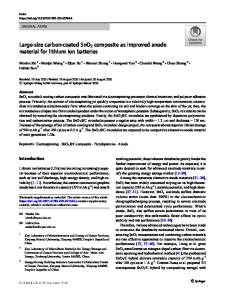Flower-like NiS/C as high-performance anode material for sodium-ion batteries
- PDF / 825,728 Bytes
- 7 Pages / 595.276 x 790.866 pts Page_size
- 100 Downloads / 451 Views
ORIGINAL PAPER
Flower-like NiS/C as high-performance anode material for sodium-ion batteries Guanghui Xia 1 & Xuebao Li 2 & Yang Gu 2 & Peng Dong 1 & Yiyong Zhang 1 & Jianguo Duan 1 & Ding Wang 1 & Yingjie Zhang 1 Received: 4 August 2020 / Revised: 18 October 2020 / Accepted: 20 October 2020 # Springer-Verlag GmbH Germany, part of Springer Nature 2020
Abstract Transition metal sulfides are the promising anode materials for high-capacity sodium-ion batteries (SIBs). However, the pitfalls of poor conductivity and large volume expansion still restrict their applications. Herein, NiS/C with a uniform flower-like structure was successfully synthesized via a glucose-assisted hydrothermal method coupled with post-annealing strategy. The petal-shaped configuration shortens the diffusion path of sodium ions in electrochemical reaction. Significantly, the formed uniform amorphous carbon is more effective in improving the electrical conductivity of electrode materials and buffering for the rapid volume change. When regarded as the anode of SIBs, the NiS/C electrode delivers a high reversible specific capacity of 1042.3 mAh g−1 at 0.1 A g−1. The excellent electrochemical performance shows that the NiS/C offers great potential for the development and research of large-scale energy storage of metal sulfide electrodes in the future. Keywords Sodium-ion batteries, Anode, Metal sulfides, NiS/C
Introduction Nowadays, lithium-ion batteries (LIBs) have been commercialized and widely used in the various branches [1–7]. However, with the explosive growth of market demand for portable electronic devices and large-scale energy storage, sodium-ion batteries (SIBs) have raised increasing attention as a promising substitutes for LIBs in virtue of natural abundance and low cost. The weakness is that the large size and high ionization potential of Na ions hinder their diffusion in the electrode materials [8]. For advanced SIBs, the rational Supplementary Information The online version contains supplementary material available at https://doi.org/10.1007/s11581-02003818-9. * Ding Wang [email protected]; [email protected] * Yingjie Zhang [email protected] 1
National and Local Joint Engineering Laboratory for Lithium-ion Batteries and Materials Preparation Technology, Key Laboratory of Advanced Battery Materials of Yunnan Province, Faculty of Metallurgical and Energy Engineering, Kunming University of Science and Technology, Kunming 650093, China
2
Faculty of Materials Science and Engineering, Kunming University of Science and Technology, Kunming 650093, China
exploration and careful design of suitable materials with high capacity and long cycle life are urgently needed, but still a major challenge [9]. The anode material is one of its extremely indispensable components for SIBs. It is responsible for providing a low redox couple. In the past decade, various alternative materials, such as carbonaceous materials, metal oxides, and metal alloys, have been intensively explored as superior anodes for SIBs [10–17]. However, due to
Data Loading...











